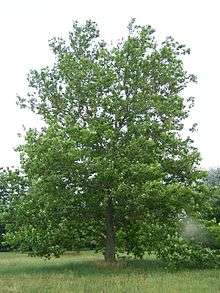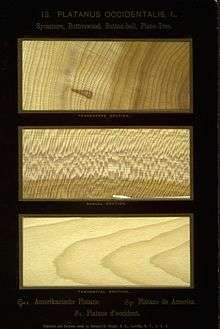Platanus occidentalis
| American Sycamore | |
|---|---|
 | |
| A young American sycamore | |
| Scientific classification | |
| Kingdom: | Plantae |
| (unranked): | Angiosperms |
| (unranked): | Eudicots |
| Order: | Proteales |
| Family: | Platanaceae |
| Genus: | Platanus |
| Species: | P. occidentalis |
| Binomial name | |
| Platanus occidentalis L. | |
 | |
Platanus occidentalis, also known as American sycamore, American planetree, occidental plane, and buttonwood, is one of the species of Platanus native to North America. It is usually called sycamore in North America, a name which can refer to other types of tree in other parts of the world. The name is derived from the Greek word πλάτανος (platanos), meaning flat, and from the Latin word occidentalis meaning "of the west." And sycamore is derived from the ancient Greek συκόμορος (sūkomoros) meaning "fig-mulberry".
Description
An American sycamore tree can often be easily distinguished from other trees by its mottled exfoliating bark which flakes off in great irregular masses, leaving the surface mottled, and greenish-white, gray and brown. The bark of all trees has to yield to a growing trunk by stretching, splitting, or infilling; the sycamore shows the process more openly than many other trees. The explanation is found in the rigid texture of the bark tissue which lacks the elasticity of the bark of some other trees, so it is incapable of stretching to accommodate the growth of the wood underneath, so the tree sloughs it off.[1]
A sycamore can grow to massive proportions, typically reaching up to 30 to 40 m (98 to 131 ft) high and 1.5 to 2 m (4.9 to 6.6 ft) in diameter when grown in deep soils. The largest of the species have been measured to 51 m (167 ft), and nearly 4 m (13 ft) in diameter. Larger specimens were recorded in historical times. In 1744, a Shenandoah Valley settler named Joseph Hampton and two sons lived for most of the year in a hollow sycamore in what is now Clarke County, Virginia.[2] In 1770, at Point Pleasant, Virginia (now in West Virginia)[3] near the junction of the Kanawha and Ohio Rivers, George Washington recorded in his journal a sycamore measuring 13.67 m (44 ft 10 in) in circumference at 91 cm (3 ft) from the ground.[4]
The sycamore tree is often divided near the ground into several secondary trunks, very free from branches. Spreading limbs at the top make an irregular, open head. Roots are fibrous. The trunks of large trees are often hollow.
Another peculiarity is the way the leaves grow sticky, green buds. In early August, most trees in general will have—nestled in the axils of their leaves—the tiny forming bud which will produce the leaves of the coming year. The sycamore branch apparently has no such buds. Instead there is an enlargement of the petiole which encloses the bud in a tight-fitting case at the base of the petiole.[1]
- Bark: Dark reddish brown, broken into oblong plate-like scales; higher on the tree, it is smooth and light gray; separates freely into thin plates which peel off and leave the surface pale yellow, or white, or greenish. Branchlets at first pale green, coated with thick pale tomentum, later dark green and smooth, finally become light gray or light reddish brown.
- Wood: Light brown, tinged with red; heavy, weak, difficult to split. Largely used for furniture and interior finish of houses, butcher's blocks. Specific gravity, 0.5678; relative density, 0.53724 g/cm3 (33.539 lb/cu ft).
- Winter buds: Large, stinky, sticky, green, and three-scaled, they form in summer within the petiole of the full grown leaf. The inner scales enlarge with the growing shake. There is no terminal bud.
- Leaves: Alternate, palmately nerved, broadly ovate or orbicular, 10 to 23 cm (4 to 9 in) inches long, truncate or cordate or wedge-shaped at base, decurrent on the petiole. Three to five-lobed by broad shallow sinuses rounded in the bottom; lobes acuminate, toothed, or entire, or undulate. They come out of the bud plicate, pale green coated with pale tomentum; when full grown are bright yellow green above, paler beneath. In autumn they turn brown and wither before falling. Petioles long, abruptly enlarged at base and inclosing the buds. Stipules with spreading, toothed borders, conspicuous on young shoots, caducous.
- Flowers: May, with the leaves; monoecious, borne in dense heads. Staminate and pistillate heads on separate peduncles. Staminate heads dark red, on axillary peduncles; pistillate heads light green tinged with red, on longer terminal peduncles. Calyx of staminate flowers three to six tiny scale-like sepals, slightly united at the base, half as long as the pointed petals. Of pistillate flowers three to six, usually four, rounded sepals, much shorter than the acute petals. Corolla of three to six thin scale-like petals.
- Stamens: In staminate flowers as many of the divisions of the calyx and opposite to them; filaments short; anthers elongated, two-celled; cells opening by lateral slits; connectives hairy.
- Pistil: Ovary superior, one-celled, sessile, ovate-oblong, surrounded at base by long, jointed, pale hairs; styles long, incurved, red, stigmatic, ovules one or two.
- Fruit: Brown heads, solitary or rarely clustered, 2.5 cm (1 in) in diameter, hanging on slender stems three to six inches long; persistent through the winter. These heads are composed of achenes about two-thirds of an inch in length. October.[1]

 The characteristic bark of an American sycamore
The characteristic bark of an American sycamore A sycamore in winter.
A sycamore in winter.- Old sycamores can have massive trunks
- Tree in autumn
- Autumn leaves
- Upper branches of a sycamore
- Sycamore trunk and branches
Distribution
In its native range, it is often found in riparian and wetland areas. The range extends from Iowa to Ontario and Maine in the north, Nebraska in the west, and south to Texas and Florida. Closely related species (see Platanus) occur in Mexico and the southwestern states of the United States. It is sometimes grown for timber, and has become naturalized in some areas outside its native range. It can be found growing successfully in Bismarck, North Dakota,[5] and it is sold as far south as Okeechobee. The American sycamore is also well adapted to life in Argentina and Australia and is quite widespread across the Australian continent especially in the cooler southern states such as Victoria and New South Wales.
Uses

The sycamore is able to endure a big city environment and was formerly extensively planted as a shade tree,[1] but due to the defacing effects of anthracnose it has been largely usurped in this function by the resistant London plane.[6]
Its wood has been used extensively for butcher’s blocks. It has been used for boxes and crates; although coarse-grained and difficult to work, it has also been used to make furniture, siding, and musical instruments.[6]
Investigations have been made into its use as a biomass crop.[7]
Pests and diseases
The American sycamore is a favored food plant of the pest sycamore leaf beetle.
American sycamore is susceptible to Plane anthracnose disease (Apiognomonia veneta, syn. Gnomonia platani), an introduced fungus found naturally on the Oriental plane P. orientalis, which has evolved considerable resistance to the disease. Although rarely killed or even seriously harmed, American sycamore is commonly partially defoliated by the disease, rendering it unsightly as a specimen tree.
Sometimes mistaken for frost damage, the disease manifests in early spring, wilting new leaves and causing mature leaves to turn brown along the veins. Infected leaves typically shrivel and fall, so that by summer the tree is regrowing its foliage. Cankers form on twigs and branches near infected leaves, serving to spread the disease by spore production and also weakening the tree. Because cankers restrict the flow of nutrients, twigs and branches afflicted by cankers eventually die. Witch's broom is a symptom reflecting the cycle of twigs dying.[8]
As a result of the fungus' damage, American sycamore is often avoided as a landscape tree, and the more resistant London plane (P. × hispanica; hybrid P. occidentalis × P. orientalis) is planted instead.
History
Herodotus recorded a time that Xerxes' was traveling through Lydia in which he found a plane-tree so beautiful, that he presented it with golden ornaments, and put it under the care of one of his Immortals in 480 BC.[9]
The terms under which the New York Stock Exchange was formed are called the "Buttonwood Agreement," because it was signed under a buttonwood (sycamore) tree at 68 Wall Street, New York City in 1792.
The sycamore made up a large part of the forests of Greenland and Arctic America during the Cretaceous and Tertiary periods. It once grew abundantly in central Europe, from which it has now disappeared.[1] It was brought to Europe early in the 17th century.[10]
See also
- Buttonball Tree, an American sycamore, said to be the largest on the East Coast, located in Sunderland, Massachusetts
- Pinchot Sycamore, an American sycamore that is the largest tree in Connecticut
- Webster Sycamore, formerly the largest American sycamore in the U.S. state of West Virginia
- Sycamore maple or European sycamore (Acer pseudoplatanus), a maple which is visually very similar to sycamore
- El Aliso, the 400 year lived powwow sycamore tree at Yaangna, the original Los Angeles
Trivia
The sycamore tree is mentioned in the famous song "Dream a Little Dream of Me" (in its 4th line), "Birds singing in the sycamore tree."
It is also mentioned in "Colors of the Wind" from Pocahontas (1995), "How high does a sycamore grow? If you cut it down, then you'll never know."
The sycamore tree is one of the main themes in movie "Flipped" (2010) where the lead character Juli Baker is greatly attached to the sycamore tree in the neighborhood.
References
- 1 2 3 4 5 Keeler, Harriet L. (1900). Our Native Trees and How to Identify Them. New York: Charles Scribner's Sons. pp. 263–268.
- ↑ Kercheval, Samuel (1833). A History of the Valley of Virginia. https://archive.org/stream/ahistoryvalleyv01jacogoog#page/n58/mode/2up/search/sycamore: Samuel H. Davis. p. 74.
- ↑ http://www.galliagenealogy.org/History/washington.htm
- ↑ Dale Luthringer (2007-03-22). "Historical sycamore dimensions". Newsgroup: Native Tree Society Eastern Native Tree Society Check
|newsgroup=value (help). Retrieved 2009-11-16. - ↑ "2012 Register of Champion Trees" (PDF). NDSU–North Dakota Forest Service. Retrieved 18 April 2013.
- 1 2 Grimm, William C. (1983). The Illustrated Book of Trees. Harrisburg, PA: Stackpole Books. pp. 257–259. ISBN 0-8117-2220-1.
- ↑ Devine, Warren D.; Tyler, Donald D.; Mullen, Michael D.; Houston, Allan E.; Joslin, John D.; Hodges, Donald G.; Tolbert, Virginia R.; Walsh, Marie E. (May 2006). "Conversion from an American sycamore (Platanus occidentalis L.) biomass crop to a no-till corn (Zea mays L.) system: Crop yields and management implications". Soil and Tillage Research. 87 (1): 101–111. doi:10.1016/j.still.2005.03.006.
- ↑ Swift, C.E. (October 2011). "Sycamore Anthracnose". Colorado State University Extension. Retrieved 18 April 2013.
- ↑ s:The History of Herodotus (Rawlinson)/Book 7
- ↑ Olmert, Michael (1996). Milton's Teeth and Ovid's Umbrella: Curiouser & Curiouser Adventures in History. New York: Simon & Schuster. p. 217. ISBN 0-684-80164-7.
Bibliography
- Fergus, Charles (2002). Trees of Pennsylvania and the Northeast. Mechanicsburg, Penn.: Stackpole Books. pp. 162–6. ISBN 978-0-8117-2092-2. OCLC 49493542. Retrieved 15 July 2014.
External links
- USDA Plants Profile for Platanus occidentalis (American sycamore)
- Flora of North America: Platanus occidentalis
- University of Michigan at Dearborn: Native American Ethnobotany of Platanus occidentalis (American sycamore)
- Cirrusimage.com: American Sycamore — diagnostic photographs and information
- Forestry.about.com: American sycamore - Platanus occidentalis
- photos of Platanus occidentalis
| Wikimedia Commons has media related to Platanus occidentalis. |